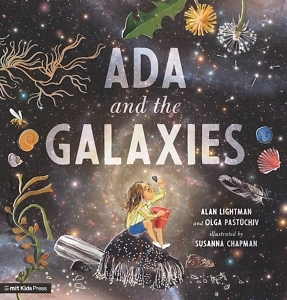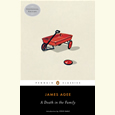The Wonder of It All
Alan Lightman explores the beauty of the night sky in his first children’s book
Author, physicist, and MIT professor Alan Lightman has spent his career pondering big questions about big ideas: Do multiverses exist? What was there, if anything, before the Big Bang? Could there have been multiple Big Bangs? Where do science and miracles intersect? He has explored such ideas in his scientific work and his award-winning fiction — in 2000, his novel The Diagnosis was a finalist for the National Book Award — as well as essays in such publications as The Atlantic, The New York Times, and Harper’s.

To his newest literary project — a picture book for children, written with Olga Pastuchiv — Lightman brings the same sense of boundless wonder that pervades all his writing. In this story, one that captures the beauty in everything from osprey nests to shells found on the beach to the magnificent night sky, young Ada visits her grandparents on an island in Maine. During the day, she explores the shore with her grandfather, whom she affectionately calls Poobah. When the fog clears and she can finally gaze at the stars, she is mesmerized. The book’s illustrations of Ada, Poobah, and the rest of the family, who marvel at the stars scudded across a breathtakingly beautiful sky, incorporate images of the Milky Way taken by the Hubble Space Telescope.
The story, Lightman told Chapter 16 via phone, was inspired by his own grandchild, also named Ada, during a visit when she was approximately five years old. He showed her a book with photographs of galaxies, images taken by Hubble. “I opened the book and didn’t say anything. Ada began looking at the pictures and turning the pages, and she had this really strong reaction to the pictures. She said, ‘These are the most beautiful things I’ve ever seen.’ She was ecstatic over them. I thought that if Ada had this powerful reaction to these beautiful pictures, maybe other children would too.”
Lightman’s and Pastuchiv’s manuscript spoke to Nashville illustrator Susanna Chapman on multiple levels. Like Ada in the story, Susanna also visited a grandparent in Maine as a child and, as she puts it, “spent a lot of time peering and inspecting, just like Ada does,” adding that the first thing she painted after reading the story was mussel shells. “They are everywhere in Maine and look just like tiny galaxies to me. I sprinkled a bunch of them (along with other starry specimens) throughout the story. It’s that kind of interconnectedness — scientific and poetic — that Alan and Olga’s story conjures so beautifully.”
 Lightman, a Memphis native, is pleased to see Ada and the Galaxies launched as the first children’s book in the inaugural list from MIT Kids Press, an imprint formed in 2020 between the university and trade publisher Candlewick Press. The imprint will publish children’s books related to science, technology, engineering, arts, and mathematics (STEAM) topics. “I think it’s a wonderful imprint,” Lightman said. “It’s a win-win. MIT as an institution has been very interested in education for decades. There are various programs at MIT that deal with K-12 education. They’re very socially aware in that regard. Having a series of children’s books that get children interested in science is an excellent idea.”
Lightman, a Memphis native, is pleased to see Ada and the Galaxies launched as the first children’s book in the inaugural list from MIT Kids Press, an imprint formed in 2020 between the university and trade publisher Candlewick Press. The imprint will publish children’s books related to science, technology, engineering, arts, and mathematics (STEAM) topics. “I think it’s a wonderful imprint,” Lightman said. “It’s a win-win. MIT as an institution has been very interested in education for decades. There are various programs at MIT that deal with K-12 education. They’re very socially aware in that regard. Having a series of children’s books that get children interested in science is an excellent idea.”
If Ada and the Galaxies is representative of what is to come from the imprint, readers are in good hands. The illustrations alone, merging watercolors and photography, capture the mystery and beauty inherent in science — in this case, both earthly and astrophysical delights. Chapman — who found wonder in both mussel shells and galaxies as a child, just as Ada and Poobah do — is also thrilled to be a part of the first offering from MIT Kids Press. “Being literal,” she adds, “is sometimes the best way to express and learn, but art can explore and wonder in a way documentation doesn’t. Including the Hubble photos within the illustrations was our endeavor to harmonize the two.”
Lightman is already working on his next book for the imprint, this one dedicated to another of his grandchildren. The story will center on a character named Isabel, who longs to see invisible things. It’s more of what Lightman excels at — a deeply curious exploration of awe-inspiring ideas.
“I’m kind of an idea person,” he says. “That’s true in my adult books, both fiction and nonfiction. I generally start with ideas. A lot of people start with characters or just single moments. I’ve always loved the children’s books that have a deeper level of ideas or meaning in them — sort of like Sesame Street, you know. The good episodes in Sesame Street are ones where adults are entertained as well as the children, because they have a deeper level. Even if children don’t grasp that, it sticks somewhere in their unconscious. I’ve always liked the children’s books that have that deeper level of significance or meaning.”

Julie Danielson, co-author of Wild Things! Acts of Mischief in Children’s Literature, writes about picture books for Kirkus Reviews, BookPage, and The Horn Book. She lives in Murfreesboro and blogs at Seven Impossible Things Before Breakfast.


